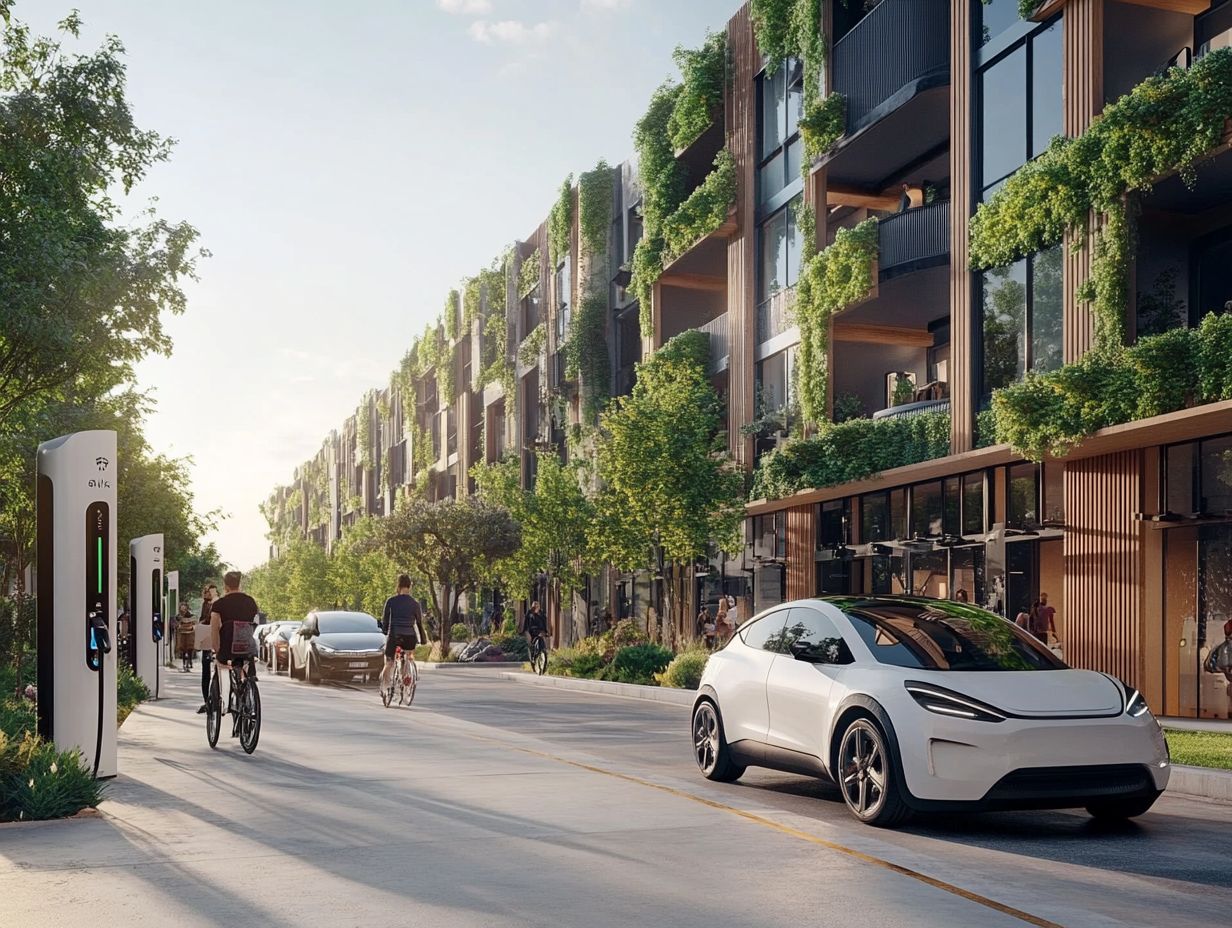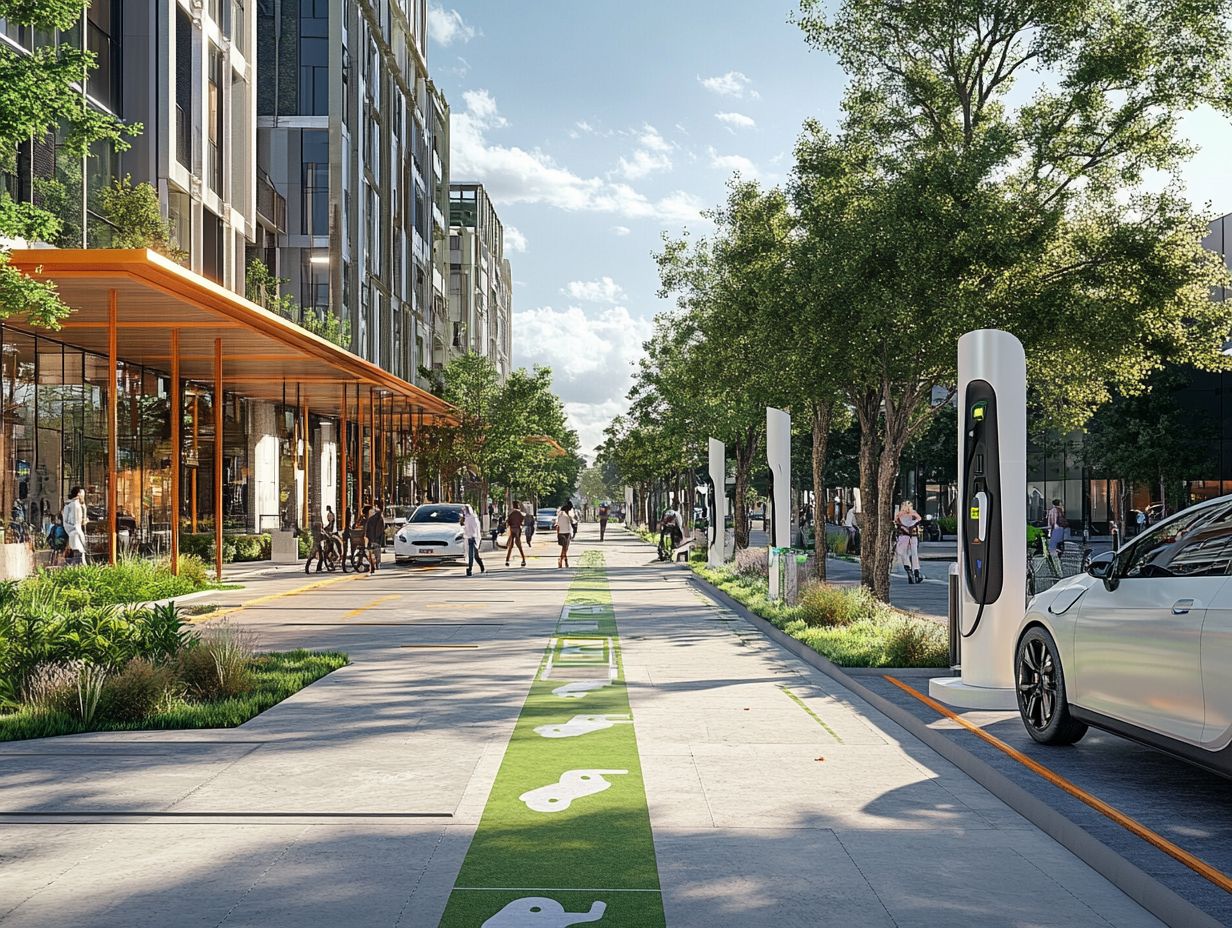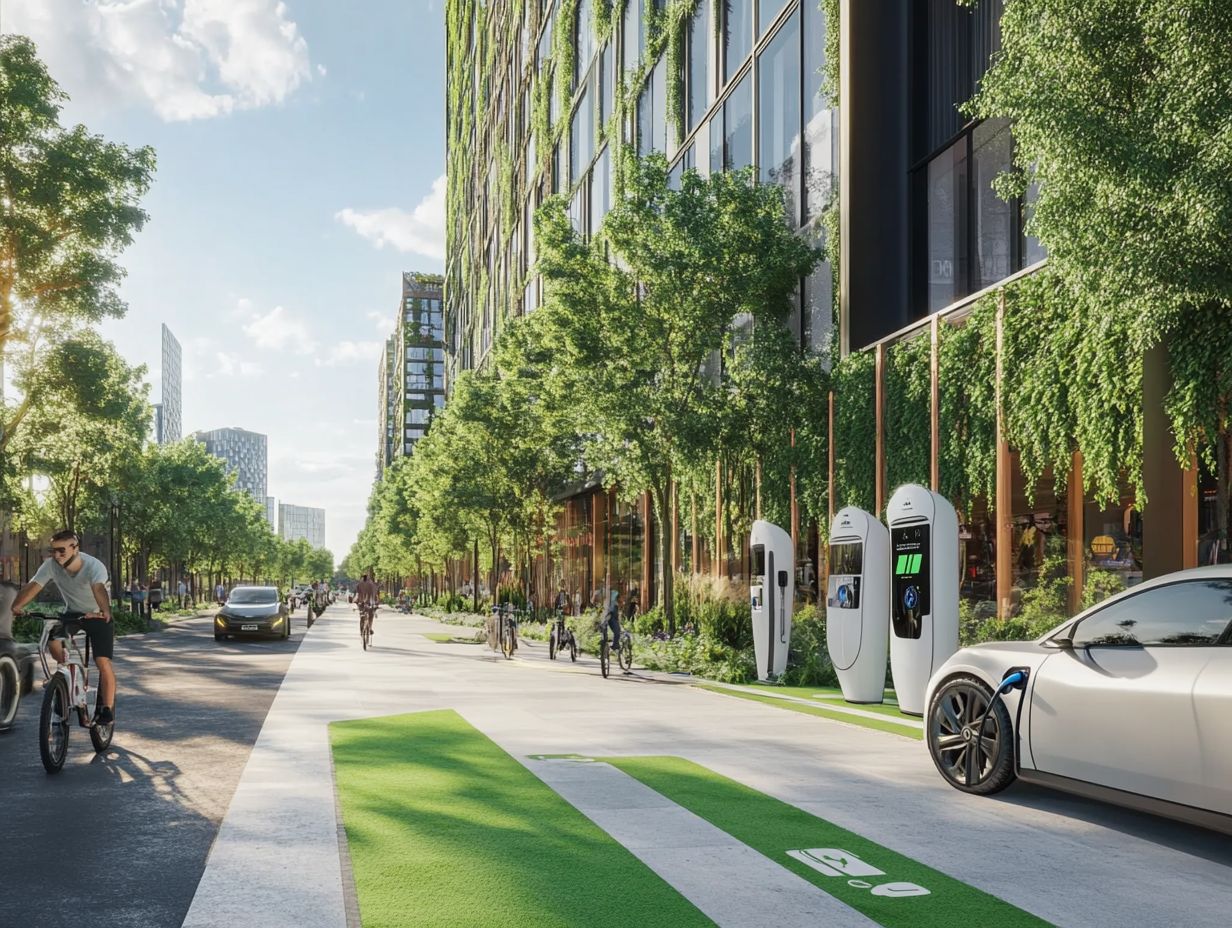The Role of Charging Stations in Urban Planning
As cities evolve to meet the demands of modern living, integrating charging stations becomes essential for sustainable urban planning.
These stations not only support the increasing number of electric vehicles (EVs) but also play a vital role in reducing carbon footprints and enhancing accessibility.
Get ready to explore the exciting benefits of charging stations! This article will guide you through the advantages of incorporating charging stations, outline the key factors for successful implementation, and address the challenges cities encounter during this transition.
Discover now how charging stations are transforming urban landscapes and paving the way for a greener future.
Contents
- Key Takeaways:
- Benefits of Incorporating Charging Stations in Urban Planning
- Factors to Consider in Implementing Charging Stations
- Challenges and Solutions for Charging Station Implementation
- The Future Looks Bright for Charging Stations in Urban Planning
- Frequently Asked Questions
- What is the role of charging stations in urban planning?
- Why are charging stations important in urban planning?
- How do charging stations impact urban planning?
- What are the benefits of incorporating charging stations into urban planning?
- What challenges are associated with integrating charging stations into urban planning?
- What are some innovative approaches to incorporating charging stations into urban planning?
Key Takeaways:

- Charging stations play a crucial role in reducing carbon footprints and promoting the use of electric vehicles, making them an important aspect of sustainable urban planning.
- Incorporating charging stations in urban planning can improve accessibility and convenience for electric vehicle owners, encouraging more people to adopt eco-friendly transportation methods.
- Proper location, infrastructure, and funding considerations are vital factors in successfully implementing charging stations in urban areas, requiring collaboration between various stakeholders in the planning process.
What are Charging Stations and Why are They Important?
Charging stations, or EV chargers, are key parts of the growing infrastructure needed for the rising number of electric vehicles in cities. These stations not only offer the convenience of public charging but also play a vital role in being ready for electric vehicles.
With fast charging capabilities, they minimize downtime, allowing you to keep moving without missing a beat. As electric mobility continues to gain traction, recognizing the significance of charging stations in facilitating sustainable urban mobility is crucial.
By acting as pivotal nodes in the electric vehicle ecosystem, these chargers help alleviate range anxiety and encourage you to shift from traditional fuel sources to cleaner alternatives. Charging technologies span a broad spectrum, from standard Level 1 chargers to high-speed DC fast chargers, each designed to meet varying needs and circumstances.
Integrating charging stations into community planning is essential. Strategically placed chargers can create an environment that not only promotes EV adoption but also champions environmental sustainability, benefiting local economies while cutting down carbon footprints.
In essence, these charging solutions transcend mere functionality; they are foundational elements in the movement toward greener urban landscapes.
Benefits of Incorporating Charging Stations in Urban Planning
Incorporating charging stations into urban planning presents a wealth of advantages, including elevated electric mobility, improved accessibility, and vital contributions to sustainability efforts, such as the role of EV charging in reducing emissions.
By actively engaging community stakeholders and weaving charging infrastructure into smart city designs, urban areas can significantly enhance the adoption of electric vehicles while fostering energy independence and efficiency.
Reducing Carbon Footprint and Encouraging Electric Vehicles
One of the most compelling benefits of implementing charging stations is their remarkable potential to lower the carbon footprint linked to traditional transportation methods. This advancement encourages the adoption of electric vehicles. By providing easy access to charging infrastructure, cities can drive a shift toward more sustainable transportation options, promoting pollution reduction as part of broader sustainability initiatives.
This accessibility also benefits the community and plays a pivotal role in nurturing a supportive ecosystem for electric vehicles. Public charging facilities can effectively alleviate range anxiety, empowering urban residents to transition from reliance on fossil fuels to cleaner alternatives.
As cities prioritize transportation planning that seamlessly integrates these charging solutions, they set the stage for a transformative shift in urban mobility. This not only makes owning an EV more practical but also aligns with a commitment to reducing greenhouse gas emissions, fostering cleaner air, and ultimately supporting the global movement toward a sustainable future.
Improving Accessibility and Convenience

Charging stations greatly enhance accessibility and convenience for you as an electric vehicle user. They offer strategically placed public charging options throughout urban areas. This increased accessibility encourages more residents like yourself to embrace electric vehicles. It also supports urban mobility by alleviating range anxiety and improving your overall experience.
Take cities like Los Angeles and Amsterdam; they have successfully established extensive networks of charging stations located near public transport hubs, shopping districts, and residential areas. These initiatives serve current electric vehicle owners and inspire potential buyers by addressing concerns about charging infrastructure.
By integrating charging solutions into the urban landscape, municipalities are making your transition to electric mobility smoother. The added convenience and reliability of charging options are closely linked to higher EV adoption rates. This paves the way for a greener future while aligning with broader sustainability goals.
Factors to Consider in Implementing Charging Stations
When implementing charging stations, there are several critical factors to consider: site planning, optimal location, necessary setup, and potential costs along with funding options.
These elements are vital for developing efficient charging networks that cater to community demands while aligning seamlessly with regional planning initiatives.
Location and Infrastructure Requirements
Choosing the right location for charging stations is paramount. It directly affects their effectiveness and accessibility. You must evaluate infrastructure needs, such as electrical capacity and proximity to the power grid, to ensure optimal functionality and seamless integration into existing transportation planning frameworks.
Traffic management considerations are crucial for determining the ideal placement of these stations. Positioning charging stations in high-traffic areas boosts their visibility and encourages spontaneous use by electric vehicle owners. Being close to urban centers is essential for easy access. Ensuring that the stations integrate well with existing transportation systems can significantly influence adoption rates.
Thoughtful site selection can lay the foundation for a more robust EV market and promote sustainable transportation solutions.
Costs and Funding Options
Understanding the costs associated with implementing charging stations and finding potential funding options is key to your project’s success. Public-private partnerships and utility upgrades can significantly aid in financing the development of charging infrastructure. This makes it more feasible for urban areas to expand their EV charging networks.
Beyond initial setup costs, which can vary greatly depending on location and technology, you’ll also want to factor in ongoing maintenance expenses to ensure reliability and user satisfaction.
Explore exciting funding opportunities such as federal grants, state incentives, and private investments to effectively alleviate financial burdens.
Collaboration between the public and private sectors offers a unique opportunity. Local governments can create supportive policies while businesses bring innovative technology solutions to the table. This ensures that the infrastructure meets the growing demand.
This synergy boosts operational efficiency and promotes the sustainable growth of electric vehicle adoption within communities.
Challenges and Solutions for Charging Station Implementation

Despite the numerous advantages of implementing charging stations, you may encounter a range of challenges and barriers that could impede progress. Addressing these concerns requires innovative solutions and active engagement with stakeholders.
Identifying potential obstacles early in the process paves the way for smoother implementation and fosters greater community acceptance of the charging infrastructure.
Addressing Concerns and Overcoming Barriers
Addressing concerns and overcoming barriers to charging station implementation involves proactive communication and engagement with community stakeholders. By identifying specific worries such as the impact on local traffic or land use regulations planners can develop targeted solutions that foster acceptance and support for charging infrastructure.
Hosting community forums can be a game-changer. These forums create a space where residents can voice their opinions and suggestions, helping planners understand local sentiments more effectively. Such initiatives have proven successful in many municipalities, where proactive outreach minimized opposition and improved project designs to better align with community needs.
Engaging with local businesses and civic organizations bridges potential gaps, ensuring diverse perspectives are included in the planning process. Presenting case studies from other cities that have integrated charging stations can provide a clear roadmap for navigating challenges while highlighting the benefits of sustainable practices (methods that are eco-friendly and reduce harm to the environment) for the community’s well-being.
The Future Looks Bright for Charging Stations in Urban Planning
The outlook for charging stations in urban planning is exceptionally promising, especially with the rapid rise in electric vehicle adoption and the emergence of smart cities focused on sustainable infrastructure.
As cities continue to evolve, embracing new charging methods and smart planning ideas will play a key role in shaping the future of urban mobility.
Potential Growth and Impact on Cities
The potential growth of charging stations in urban areas can significantly transform cities, enhancing infrastructure while creating an environment ripe for electric vehicle adoption. Investing in charging infrastructure paves the way for improved urban mobility and reduced pollution levels, aligning with global sustainability initiatives.
This anticipated expansion not only makes access easier for electric vehicle owners but also encourages those who are hesitant to make the switch, knowing that a supportive network is in place. Strategically placing charging stations in high-traffic areas enhances their visibility and usability, meeting the needs of urban residents who rely on efficient transportation.
Ultimately, integrating charging facilities demonstrates a commitment to sustainable transport solutions, contributing to a cleaner, more efficient urban landscape that supports broader environmental goals.
Frequently Asked Questions

What is the role of charging stations in urban planning?
The role of charging stations in urban planning is to support the adoption of electric vehicles (EVs) by providing convenient access to charging infrastructure for EV owners. Understanding the benefits of public charging stations can further reduce emissions and promote sustainable transportation in cities.
Why are charging stations important in urban planning?
Charging stations are crucial in urban planning because they help reduce air pollution and greenhouse gas emissions from transportation. They also encourage the use of electric vehicles, decreasing dependence on fossil fuels and promoting a more sustainable future for cities.
How do charging stations impact urban planning?
Charging stations influence urban planning by affecting the design and layout of cities. Where charging stations are placed and how easy they are to reach can change the location of new developments, transportation infrastructure, traffic flow, and the use of public spaces.
What are the benefits of incorporating charging stations into urban planning?
Incorporating charging stations into urban planning has numerous benefits, such as reducing air pollution and greenhouse gas emissions, promoting sustainable transportation, and attracting businesses and residents who prioritize environmentally friendly infrastructure.
Join us in advocating for more charging stations! Together, we can make our cities greener!
What challenges are associated with integrating charging stations into urban planning?
Integrating charging stations into urban areas can be costly. Upgrading existing electrical systems may be necessary, which adds to the expense.
Finding suitable locations for these stations in dense urban settings can also be quite challenging. Effective planning is crucial to ensure accessibility.
What are some innovative approaches to incorporating charging stations into urban planning?
Innovative strategies for adding charging stations include using renewable energy sources to power them. Smart charging technology can help optimize electricity use, making it more efficient.
Another exciting approach is incorporating charging stations into existing public transport hubs like bus stops or train stations. This creates convenience for commuters and promotes electric vehicle use.





